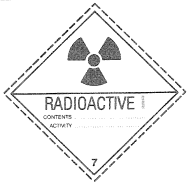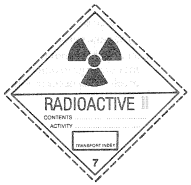- Latest available (Revised)
- Original (As made)
Dangerous Substances in Harbour Areas Regulations (Northern Ireland) 1991
You are here:
More Resources
Status:
This is the original version (as it was originally made). This item of legislation is currently only available in its original format.
Regulations 2(1), 3(1) and (2)
SCHEDULE 1The Classification of and Hazard Warning Signs for Dangerous Substances
PART ITABLE OF CHARACTERISTIC PROPERTIES, CLASSIFICATIONS AND HAZARD WARNING SIGNS
| (1) | (2) | (3) |
|---|---|---|
| Characteristic properties of the substance | Classification | Hazard warning sign |
| ||
A substance which— (a) has a critical temperature below 50°C or which at 50°C has a vapour pressure of more than 3 bar absolute; and (b) is conveyed at a pressure of more than 500 millibar above atmospheric pressure or in liquefied form; other than a toxic gas or a flammable gas. | Class 2 (Non-flammable compressed gas) | 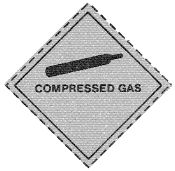 |
| A substance which has a critical temperature below 50°C or which at 50°C has a vapour pressure of more than 3 bar absolute and which is toxic. | Class 2 (Toxic gas) |  |
| A substance which has a critical temperature below 50°C or which at 50°C has a vapour pressure of more than 3 bar absolute and is flammable. (See Note 1). | Class 2 (Flammable gas) |  |
A liquid with a flash point of 55°C or below except a liquid which— (a) has a flash point equal to or more than 2 1°C and less than or equal to 55°C and (b) when tested at 55°C i the manner described in Schedule 2 to the Highly Flammable Liquids and Liquefied Petroleum Gases Regulations (Northern Ireland) 1975(1) doe not support combustion. (See Notes 2 to 4). | Class 3 (Flammable liquid) | 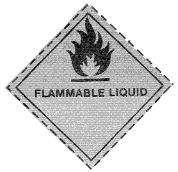 |
| A solid which is readily combustible under condition encountered in a harbour or harbour area or which may cause or contribute to fire through friction. | Class 4.1 (Flammable solid) |  |
| A substance which is liable to spontaneous heating under conditions encountered in a harbour or harbour area or to heating in contact with air being then liable to catch fire | Class 4.2 (Spontaneously combustible substance) |  |
| A substance which in contact with water is liable to become spontaneously combustible or to give off a flammable gas. | Class 4.3 (Substance which in contact with water emits flammable gas) | 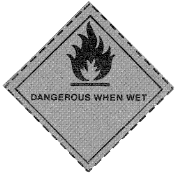 |
| A substance other than an organic peroxide, which, although not itself necessarily combustible, may by yielding oxygen or by a similar process cause or contribute to the combustion of other material. | Class 5.1 (Oxidizing substance) |  |
A substance which is— (a) an organic peroxide; and (b) an unstable substance which may undergo exothermic self-accelerating decomposition. | Class 5.2 Organic peroxide) |  |
| A substance known to be so toxic to man as to afford a hazard to health under conditions encountered in a harbour or harbour area or which, in the absence of adequate data on human toxicity, is presumed to be toxic to man. | Class 6.1 (Toxic substance) |  |
| A substance known to be toxic to man or, in the absence of adequate data on human toxicity, is presumed to be toxic to man but which is unlikely to afford a serious acute hazard to health under conditions encountered in a harbour or harbour area. | Class 6.1 (Harmful substance) | 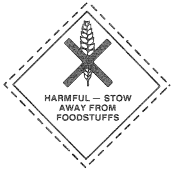 |
| A substance which contains disease-producing microorganisms. | Class 6.2 (Infectious substance) |  |
| A substance of specific activity of more than 70 Becquerels per gram (0.002 microcuries per gram) (See Note 5). | Class 7 (Radioactive substance) | |
A substance which by chemical action will— (a) cause severe damage when in contact with living tissue, or (b) materially damage other freight or equipment if leakage occurs. | Class 8 Corrosive substance) |  |
| Two or more dangerous substances having different classifications. | Multi-load | |
An explosive substance, that is to say— (a) a solid or liquid substance, or (b) a mixture of solid or liquid substances or both, which is capable by chemical reaction in itself of producing gas at such a temperature and pressure and at such a speed as could cause damage to surroundings, including one or more such substances contained in an article and which has a predominant hazard appropriate to another Class but which nevertheless presents a significant hazard from explosion. | According to the predominant hazard | |
PART IISPECIFICATION OF HAZARD WARNING SIGNS
1. The hazard warning sign to be used on a hazard warning panel, on a label to be affixed to a compartmented tank barge or to be affixed to a freight container, portable tank or receptacle shall be that shown in column 3 of Part I for the classification of the substance shown in the corresponding entry in column 2, and the signs shall conform in form and colour to those shown in column 3, except that—
(a)in the case of the signs for the classifications “non-flammable compressed gas”, “flammable gas”, “flammable liquid” and “substance which in contact with water emits flammable gas”, the symbol and lettering may be in white;
(b)in the case of the sign for the classification “spontaneously combustible substance”, the lettering may be in white;
(c)in the case of the signs for the classifications “oxidizing substance” and “organic peroxide”, the part of the symbol showing the flame may be completely in black;
(d)in place of the word “toxic”, the word “poison” may be used wherever it occurs;
(e)in place of the word “flammable”, the word “inflammable” may be used
(f)the sign may show ;he class number in accordance with the IMDG Code and in the case of Class 7 must show the Class number.
2. Each hazard warning sign shall be in the form of a square set with its sides at an angle of 45° to the vertical and the length of the sides shall be—
(a)in the case of signs on hazard warning panels, not less than 200 millimetres;
(b)in the case of signs on the labels for compartmented tank barges, not less than 95 millimetres;
(c)in the case of signs, other than those for substances in Class 7, to be affixed to a freight container, portable tank or receptacle, not less than 100 millimetres. except that, in the case of receptacles that are of such dimensions that they can only bear smaller signs, the sign should be as large as is reasonably practicable;
(d)in the case of signs for substances in Class 7 to be affixed to a freight container, portable tank or receptacle, 100 millimetres.
3. Hazard warning signs to be affixed to a freight container, portable tank or receptacle shall have a line of the same colour as the symbol, 5 millimetres inside the edge and running parallel to it. (The broken line which surrounds each sign delineates the edge of that sign and need not be shown.)
4. Hazard warning signs to be affixed to hazard warning panels and labels for compartmented tank barges, shall for any part of the sign that is not black have a black border—
(a)in the case of signs for hazard warning panels, at least 2 millimetres wide;
(b)in the case of signs for labels, at least 1 millimetre wide.
Options/Help
Print Options
PrintThe Whole Rule
PrintThis Schedule only
Legislation is available in different versions:
Latest Available (revised):The latest available updated version of the legislation incorporating changes made by subsequent legislation and applied by our editorial team. Changes we have not yet applied to the text, can be found in the ‘Changes to Legislation’ area.
Original (As Enacted or Made): The original version of the legislation as it stood when it was enacted or made. No changes have been applied to the text.
More Resources
Access essential accompanying documents and information for this legislation item from this tab. Dependent on the legislation item being viewed this may include:
- the original print PDF of the as enacted version that was used for the print copy
- lists of changes made by and/or affecting this legislation item
- confers power and blanket amendment details
- all formats of all associated documents
- correction slips
- links to related legislation and further information resources
More Resources
Use this menu to access essential accompanying documents and information for this legislation item. Dependent on the legislation item being viewed this may include:
- the original print PDF of the as made version that was used for the print copy
- correction slips
Click 'View More' or select 'More Resources' tab for additional information including:
- lists of changes made by and/or affecting this legislation item
- confers power and blanket amendment details
- all formats of all associated documents
- links to related legislation and further information resources
